stop start DODGE VIPER 2017 VX / 3.G User Guide
[x] Cancel search | Manufacturer: DODGE, Model Year: 2017, Model line: VIPER, Model: DODGE VIPER 2017 VX / 3.GPages: 329, PDF Size: 2.83 MB
Page 193 of 329
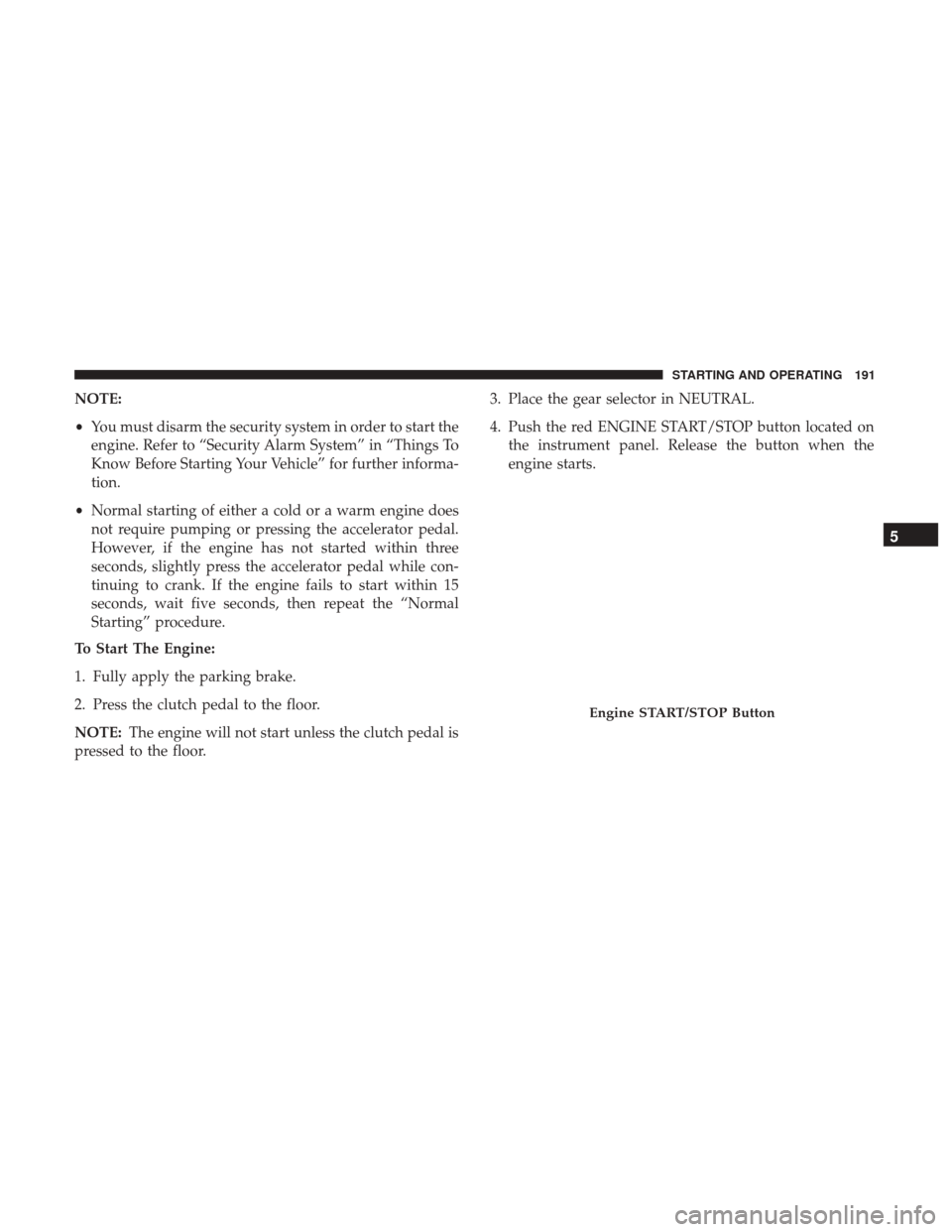
NOTE:
•You must disarm the security system in order to start the
engine. Refer to “Security Alarm System” in “Things To
Know Before Starting Your Vehicle” for further informa-
tion.
• Normal starting of either a cold or a warm engine does
not require pumping or pressing the accelerator pedal.
However, if the engine has not started within three
seconds, slightly press the accelerator pedal while con-
tinuing to crank. If the engine fails to start within 15
seconds, wait five seconds, then repeat the “Normal
Starting” procedure.
To Start The Engine:
1. Fully apply the parking brake.
2. Press the clutch pedal to the floor.
NOTE: The engine will not start unless the clutch pedal is
pressed to the floor. 3. Place the gear selector in NEUTRAL.
4. Push the red ENGINE START/STOP button located on
the instrument panel. Release the button when the
engine starts.
Engine START/STOP Button
5
STARTING AND OPERATING 191
Page 196 of 329

The spring will try to pull the gear selector toward third
and fourth gear. Make sure you move the gear selector into
second or fifth gear. If you let the gear selector move in the
direction of the pulling, you may end shifting from first to
fourth or from sixth to third gear.
You will find it easier to use only the lower gears for most
city driving. For steady highway driving with light accel-
erations, sixth gear is recommended.
Never drive with your foot resting on the clutch pedal, or
try to hold the vehicle on a hill with the clutch pedal
partially engaged. This will cause abnormal wear on the
clutch.
Never shift into REVERSE until the vehicle has come to a
complete stop.
NOTE:
•Your vehicle is equipped with a transmission reverse
inhibitor system. When vehicle speed is greater than
3 mph (5 km/h), the reverse inhibitor activates to help
prevent shifts into REVERSE. When at a complete stop,
you may notice light shift efforts into REVERSE with the
ignition in the ON position, and increased shift efforts into REVERSE with the ignition in the OFF position.
This is normal operation of the transmission reverse
inhibitor system.
• Shifting gears during cold weather may require an
increased effort until the transmission lubricant is warm.
This is normal and not harmful to the transmission.
• Due to the high performance nature of your drivetrain,
a certain amount of noise from the transmission is
normal. This noise can be most noticeable when the
vehicle is idling in NEUTRAL with the clutch engaged
(clutch pedal released), but it may also be heard when
driving. The noise may also be more noticeable when the
transmission is warm. This noise is normal and is not an
indication of a problem with your clutch or transmis-
sion.
• You must always use first gear (or REVERSE) when
starting from a standing position.
CAUTION!
Always make sure the vehicle comes to a complete stop
before shifting into REVERSE. Failure to do so may
result in transmission damage.
194 STARTING AND OPERATING
Page 198 of 329
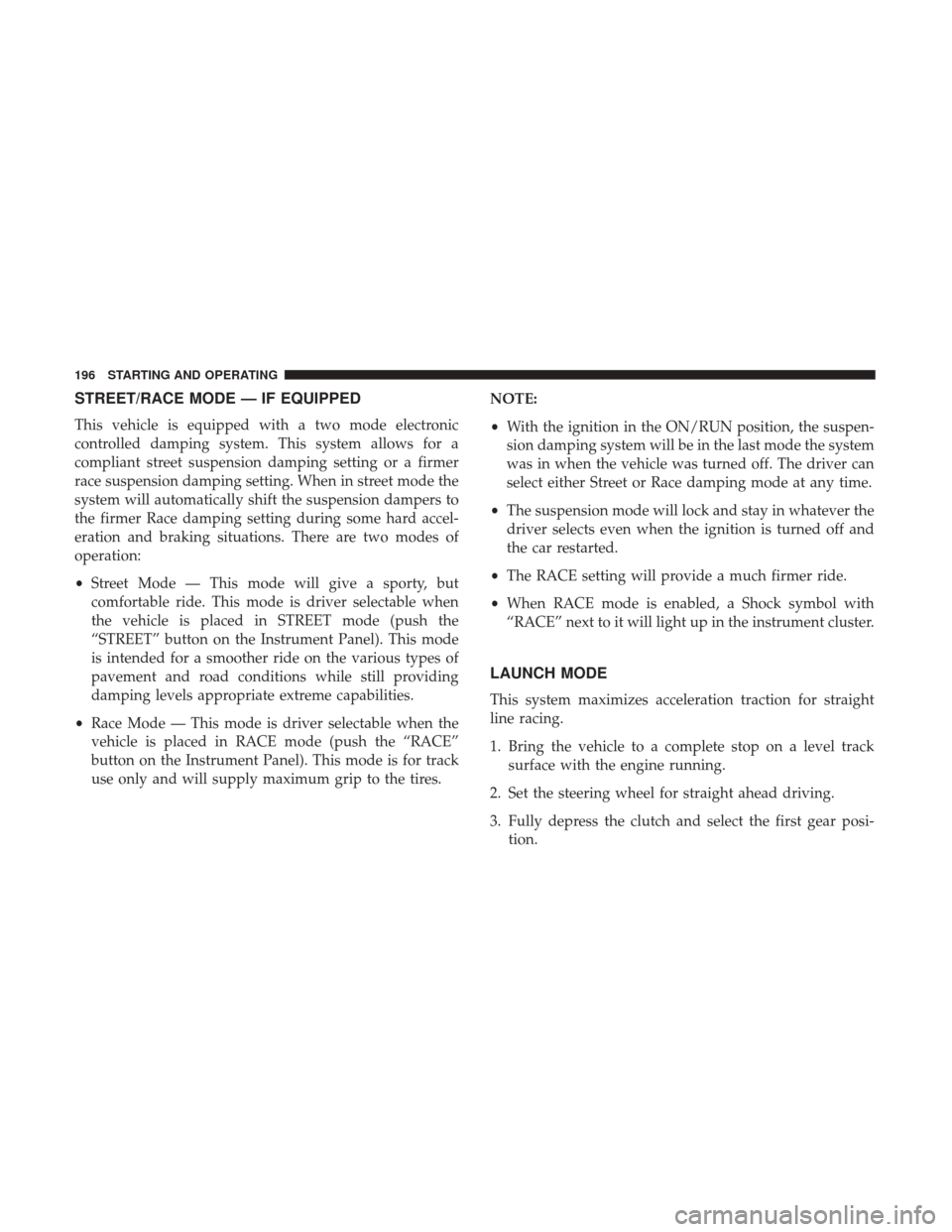
STREET/RACE MODE — IF EQUIPPED
This vehicle is equipped with a two mode electronic
controlled damping system. This system allows for a
compliant street suspension damping setting or a firmer
race suspension damping setting. When in street mode the
system will automatically shift the suspension dampers to
the firmer Race damping setting during some hard accel-
eration and braking situations. There are two modes of
operation:
•Street Mode — This mode will give a sporty, but
comfortable ride. This mode is driver selectable when
the vehicle is placed in STREET mode (push the
“STREET” button on the Instrument Panel). This mode
is intended for a smoother ride on the various types of
pavement and road conditions while still providing
damping levels appropriate extreme capabilities.
• Race Mode — This mode is driver selectable when the
vehicle is placed in RACE mode (push the “RACE”
button on the Instrument Panel). This mode is for track
use only and will supply maximum grip to the tires. NOTE:
•
With the ignition in the ON/RUN position, the suspen-
sion damping system will be in the last mode the system
was in when the vehicle was turned off. The driver can
select either Street or Race damping mode at any time.
• The suspension mode will lock and stay in whatever the
driver selects even when the ignition is turned off and
the car restarted.
• The RACE setting will provide a much firmer ride.
• When RACE mode is enabled, a Shock symbol with
“RACE” next to it will light up in the instrument cluster.
LAUNCH MODE
This system maximizes acceleration traction for straight
line racing.
1. Bring the vehicle to a complete stop on a level track surface with the engine running.
2. Set the steering wheel for straight ahead driving.
3. Fully depress the clutch and select the first gear posi- tion.
196 STARTING AND OPERATING
Page 200 of 329
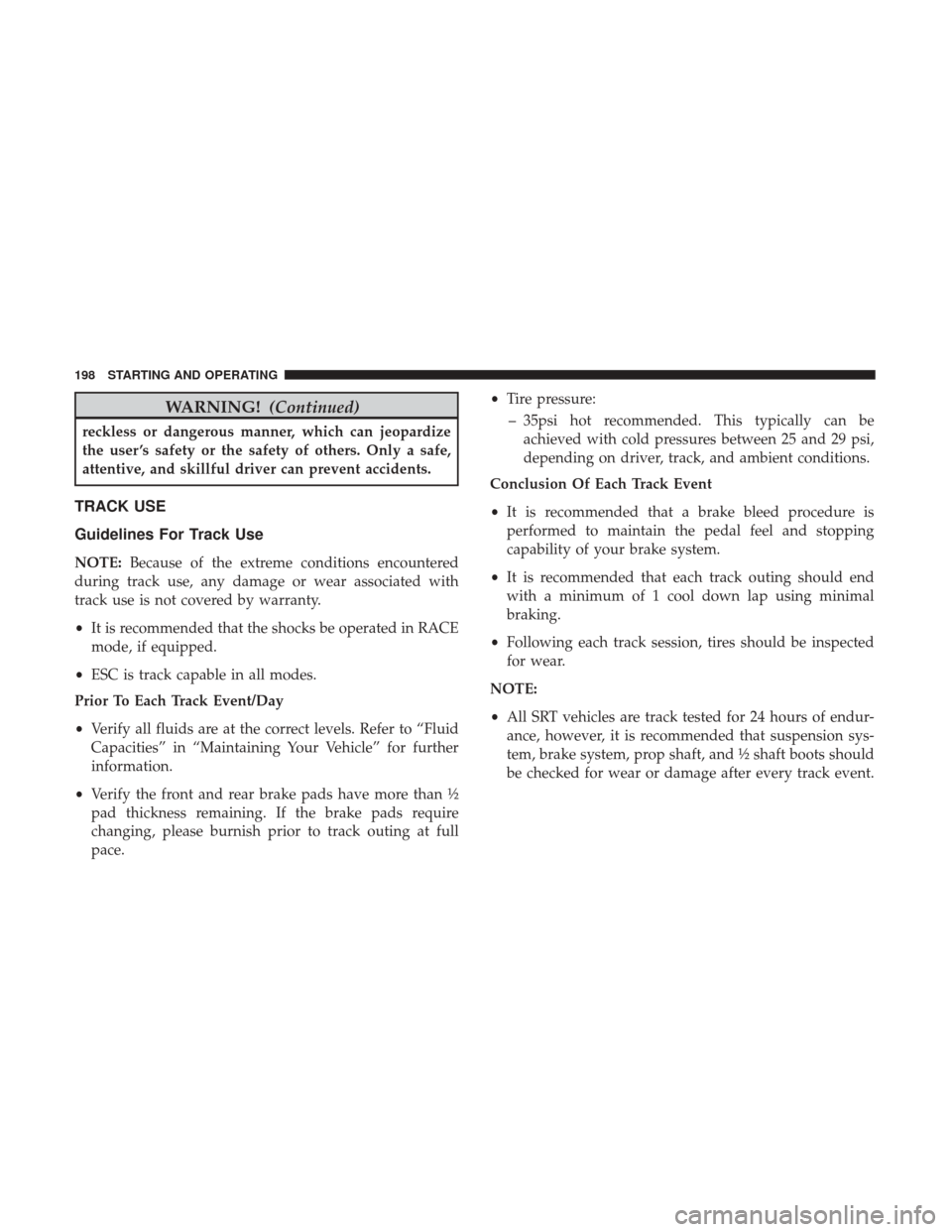
WARNING!(Continued)
reckless or dangerous manner, which can jeopardize
the user ’s safety or the safety of others. Only a safe,
attentive, and skillful driver can prevent accidents.
TRACK USE
Guidelines For Track Use
NOTE:Because of the extreme conditions encountered
during track use, any damage or wear associated with
track use is not covered by warranty.
• It is recommended that the shocks be operated in RACE
mode, if equipped.
• ESC is track capable in all modes.
Prior To Each Track Event/Day
• Verify all fluids are at the correct levels. Refer to “Fluid
Capacities” in “Maintaining Your Vehicle” for further
information.
• Verify the front and rear brake pads have more than ½
pad thickness remaining. If the brake pads require
changing, please burnish prior to track outing at full
pace. •
Tire pressure:
– 35psi hot recommended. This typically can be achieved with cold pressures between 25 and 29 psi,
depending on driver, track, and ambient conditions.
Conclusion Of Each Track Event
• It is recommended that a brake bleed procedure is
performed to maintain the pedal feel and stopping
capability of your brake system.
• It is recommended that each track outing should end
with a minimum of 1 cool down lap using minimal
braking.
• Following each track session, tires should be inspected
for wear.
NOTE:
• All SRT vehicles are track tested for 24 hours of endur-
ance, however, it is recommended that suspension sys-
tem, brake system, prop shaft, and ½ shaft boots should
be checked for wear or damage after every track event.
198 STARTING AND OPERATING
Page 201 of 329

•Track usage results in increased operating temperatures
of the engine, transmission, clutch, driveline and brake
system. This may affect noise (NVH) countermeasures
designed into your vehicle. New components may need
to be installed to return the system to the original NVH
performance.
For ACR models, please review the supplemental manual
for track tips.
DRIVING ON SLIPPERY SURFACES
Acceleration
WARNING!
Rapid acceleration on slippery surfaces is dangerous.
You could lose control of the vehicle and possibly have
a collision. Accelerate slowly and carefully whenever
there is likely to be poor traction (ice, snow, wet, mud,
loose sand, etc.).
Traction
When driving on wet or slushy roads, it is possible for a
wedge of water to build up between the tire and road
surface. This is hydroplaning and may cause partial or
complete loss of vehicle control and stopping ability. To
reduce this possibility, the following precautions should be
observed:
1. Slow down during rainstorms or when roads are slushy.
2. Slow down if road has standing water or puddles.
CAUTION!
Driving your vehicle through deep puddles at speeds
over 5 mph (8 km/h), may cause water to be ingested
into the engine. This can cause severe engine damage.
3. Replace tires when tread wear indicators first become visible.
4. Keep tires properly inflated.
5. Maintain enough distance between your vehicle and the vehicle in front of you to avoid a collision in a sudden
stop.
5
STARTING AND OPERATING 199
Page 202 of 329
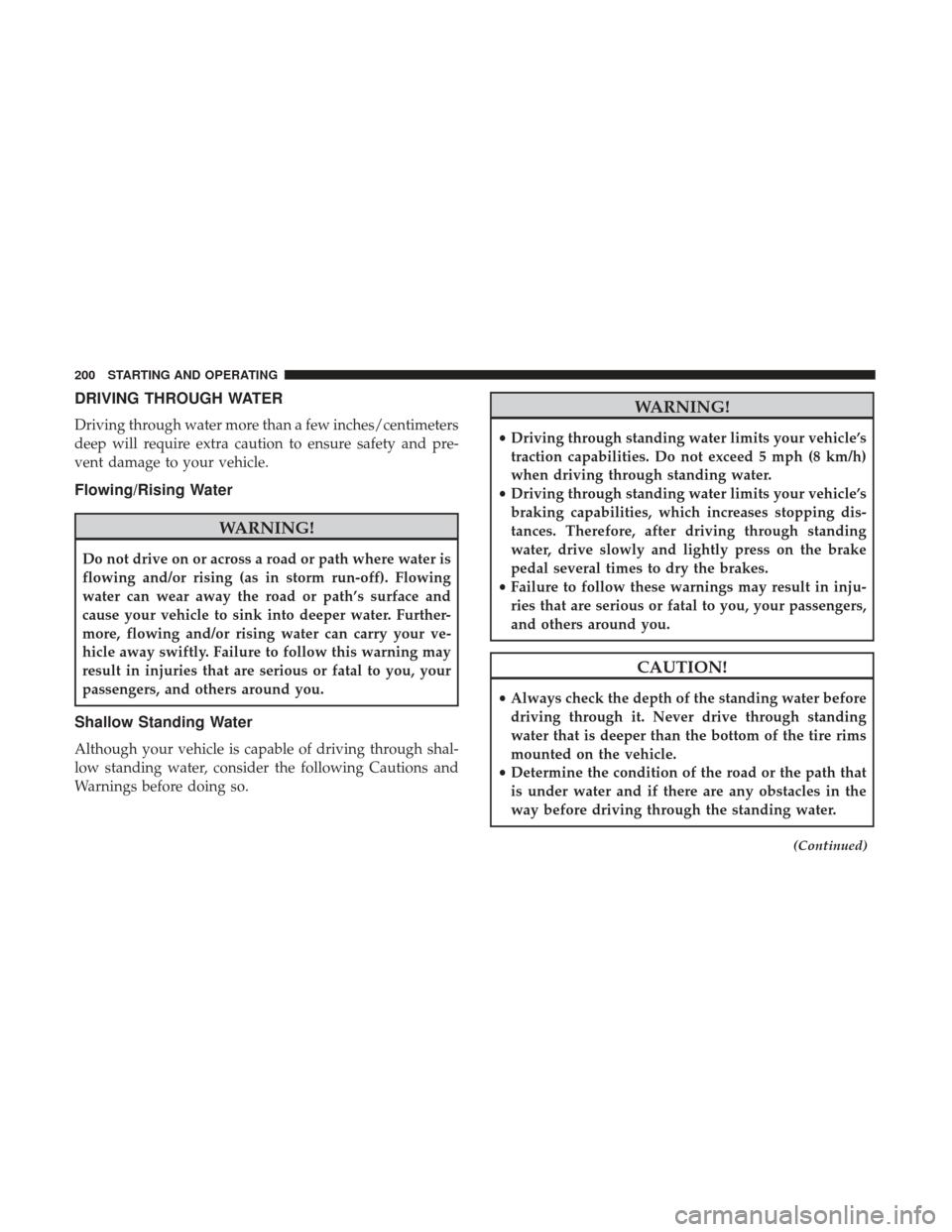
DRIVING THROUGH WATER
Driving through water more than a few inches/centimeters
deep will require extra caution to ensure safety and pre-
vent damage to your vehicle.
Flowing/Rising Water
WARNING!
Do not drive on or across a road or path where water is
flowing and/or rising (as in storm run-off). Flowing
water can wear away the road or path’s surface and
cause your vehicle to sink into deeper water. Further-
more, flowing and/or rising water can carry your ve-
hicle away swiftly. Failure to follow this warning may
result in injuries that are serious or fatal to you, your
passengers, and others around you.
Shallow Standing Water
Although your vehicle is capable of driving through shal-
low standing water, consider the following Cautions and
Warnings before doing so.
WARNING!
•Driving through standing water limits your vehicle’s
traction capabilities. Do not exceed 5 mph (8 km/h)
when driving through standing water.
• Driving through standing water limits your vehicle’s
braking capabilities, which increases stopping dis-
tances. Therefore, after driving through standing
water, drive slowly and lightly press on the brake
pedal several times to dry the brakes.
• Failure to follow these warnings may result in inju-
ries that are serious or fatal to you, your passengers,
and others around you.
CAUTION!
• Always check the depth of the standing water before
driving through it. Never drive through standing
water that is deeper than the bottom of the tire rims
mounted on the vehicle.
• Determine the condition of the road or the path that
is under water and if there are any obstacles in the
way before driving through the standing water.
(Continued)
200 STARTING AND OPERATING
Page 205 of 329
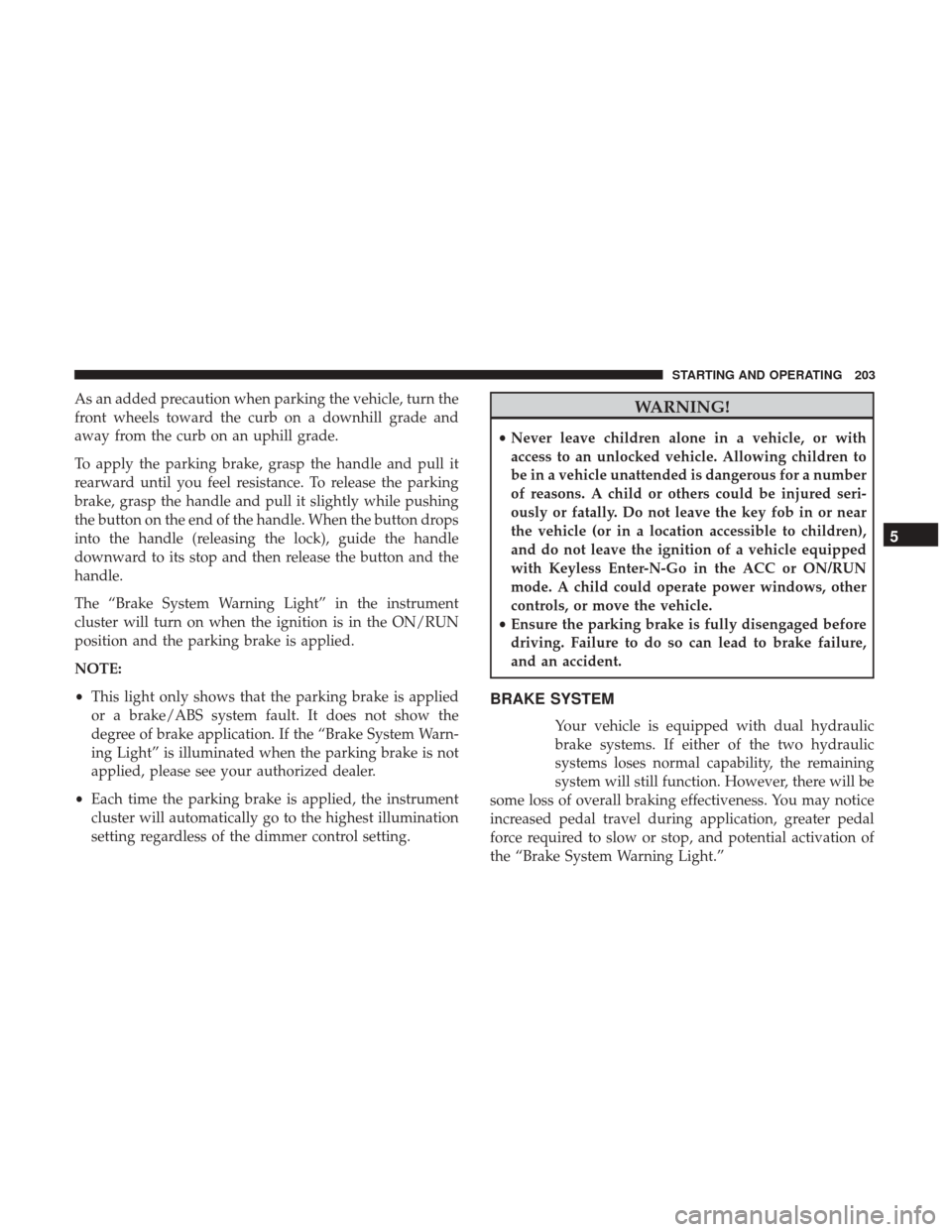
As an added precaution when parking the vehicle, turn the
front wheels toward the curb on a downhill grade and
away from the curb on an uphill grade.
To apply the parking brake, grasp the handle and pull it
rearward until you feel resistance. To release the parking
brake, grasp the handle and pull it slightly while pushing
the button on the end of the handle. When the button drops
into the handle (releasing the lock), guide the handle
downward to its stop and then release the button and the
handle.
The “Brake System Warning Light” in the instrument
cluster will turn on when the ignition is in the ON/RUN
position and the parking brake is applied.
NOTE:
•This light only shows that the parking brake is applied
or a brake/ABS system fault. It does not show the
degree of brake application. If the “Brake System Warn-
ing Light” is illuminated when the parking brake is not
applied, please see your authorized dealer.
• Each time the parking brake is applied, the instrument
cluster will automatically go to the highest illumination
setting regardless of the dimmer control setting.WARNING!
• Never leave children alone in a vehicle, or with
access to an unlocked vehicle. Allowing children to
be in a vehicle unattended is dangerous for a number
of reasons. A child or others could be injured seri-
ously or fatally. Do not leave the key fob in or near
the vehicle (or in a location accessible to children),
and do not leave the ignition of a vehicle equipped
with Keyless Enter-N-Go in the ACC or ON/RUN
mode. A child could operate power windows, other
controls, or move the vehicle.
• Ensure the parking brake is fully disengaged before
driving. Failure to do so can lead to brake failure,
and an accident.
BRAKE SYSTEM
Your vehicle is equipped with dual hydraulic
brake systems. If either of the two hydraulic
systems loses normal capability, the remaining
system will still function. However, there will be
some loss of overall braking effectiveness. You may notice
increased pedal travel during application, greater pedal
force required to slow or stop, and potential activation of
the “Brake System Warning Light.”
5
STARTING AND OPERATING 203
Page 206 of 329
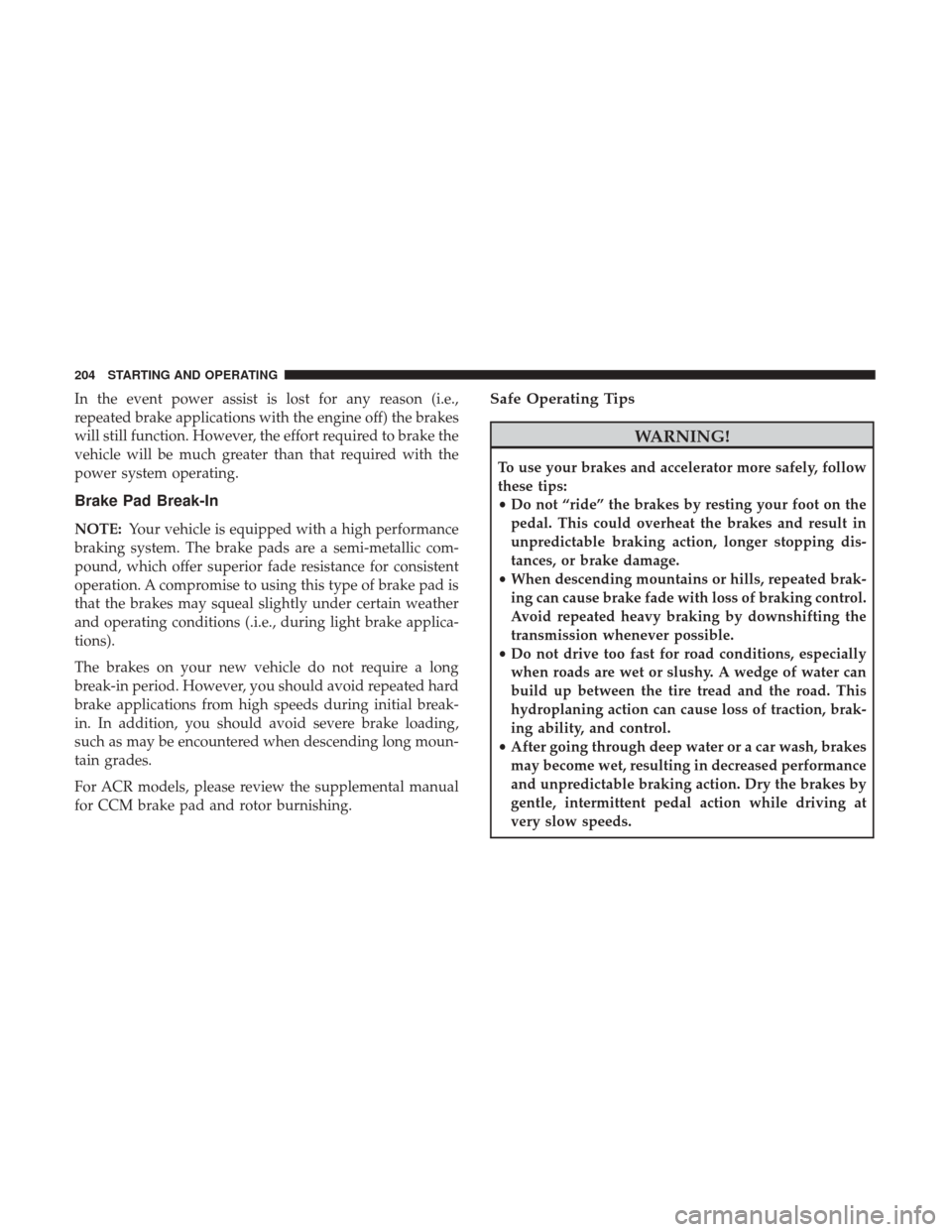
In the event power assist is lost for any reason (i.e.,
repeated brake applications with the engine off) the brakes
will still function. However, the effort required to brake the
vehicle will be much greater than that required with the
power system operating.
Brake Pad Break-In
NOTE:Your vehicle is equipped with a high performance
braking system. The brake pads are a semi-metallic com-
pound, which offer superior fade resistance for consistent
operation. A compromise to using this type of brake pad is
that the brakes may squeal slightly under certain weather
and operating conditions (.i.e., during light brake applica-
tions).
The brakes on your new vehicle do not require a long
break-in period. However, you should avoid repeated hard
brake applications from high speeds during initial break-
in. In addition, you should avoid severe brake loading,
such as may be encountered when descending long moun-
tain grades.
For ACR models, please review the supplemental manual
for CCM brake pad and rotor burnishing.
Safe Operating Tips
WARNING!
To use your brakes and accelerator more safely, follow
these tips:
• Do not “ride” the brakes by resting your foot on the
pedal. This could overheat the brakes and result in
unpredictable braking action, longer stopping dis-
tances, or brake damage.
• When descending mountains or hills, repeated brak-
ing can cause brake fade with loss of braking control.
Avoid repeated heavy braking by downshifting the
transmission whenever possible.
• Do not drive too fast for road conditions, especially
when roads are wet or slushy. A wedge of water can
build up between the tire tread and the road. This
hydroplaning action can cause loss of traction, brak-
ing ability, and control.
• After going through deep water or a car wash, brakes
may become wet, resulting in decreased performance
and unpredictable braking action. Dry the brakes by
gentle, intermittent pedal action while driving at
very slow speeds.
204 STARTING AND OPERATING
Page 207 of 329
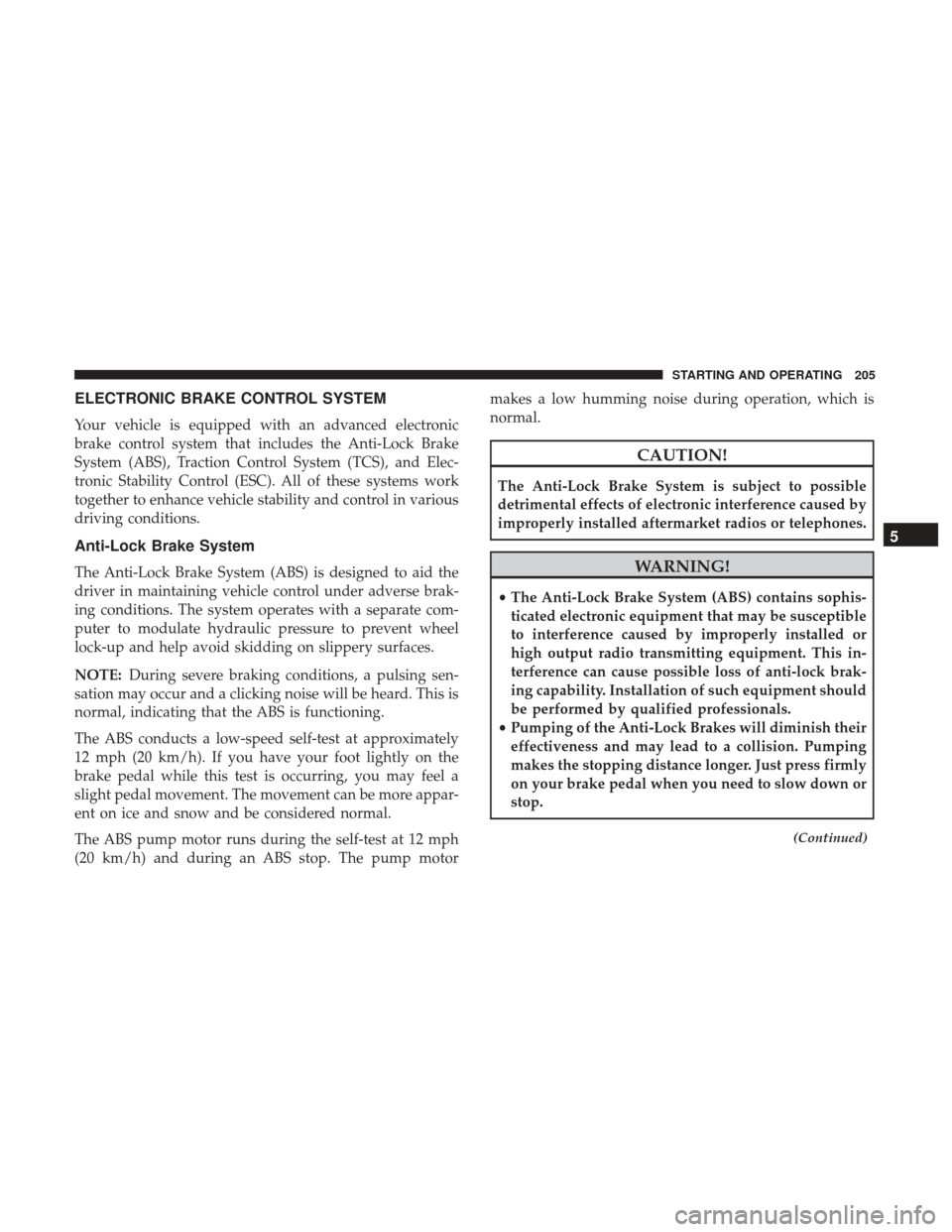
ELECTRONIC BRAKE CONTROL SYSTEM
Your vehicle is equipped with an advanced electronic
brake control system that includes the Anti-Lock Brake
System (ABS), Traction Control System (TCS), and Elec-
tronic Stability Control (ESC). All of these systems work
together to enhance vehicle stability and control in various
driving conditions.
Anti-Lock Brake System
The Anti-Lock Brake System (ABS) is designed to aid the
driver in maintaining vehicle control under adverse brak-
ing conditions. The system operates with a separate com-
puter to modulate hydraulic pressure to prevent wheel
lock-up and help avoid skidding on slippery surfaces.
NOTE:During severe braking conditions, a pulsing sen-
sation may occur and a clicking noise will be heard. This is
normal, indicating that the ABS is functioning.
The ABS conducts a low-speed self-test at approximately
12 mph (20 km/h). If you have your foot lightly on the
brake pedal while this test is occurring, you may feel a
slight pedal movement. The movement can be more appar-
ent on ice and snow and be considered normal.
The ABS pump motor runs during the self-test at 12 mph
(20 km/h) and during an ABS stop. The pump motor makes a low humming noise during operation, which is
normal.
CAUTION!
The Anti-Lock Brake System is subject to possible
detrimental effects of electronic interference caused by
improperly installed aftermarket radios or telephones.
WARNING!
•
The Anti-Lock Brake System (ABS) contains sophis-
ticated electronic equipment that may be susceptible
to interference caused by improperly installed or
high output radio transmitting equipment. This in-
terference can cause possible loss of anti-lock brak-
ing capability. Installation of such equipment should
be performed by qualified professionals.
• Pumping of the Anti-Lock Brakes will diminish their
effectiveness and may lead to a collision. Pumping
makes the stopping distance longer. Just press firmly
on your brake pedal when you need to slow down or
stop.
(Continued)
5
STARTING AND OPERATING 205
Page 208 of 329
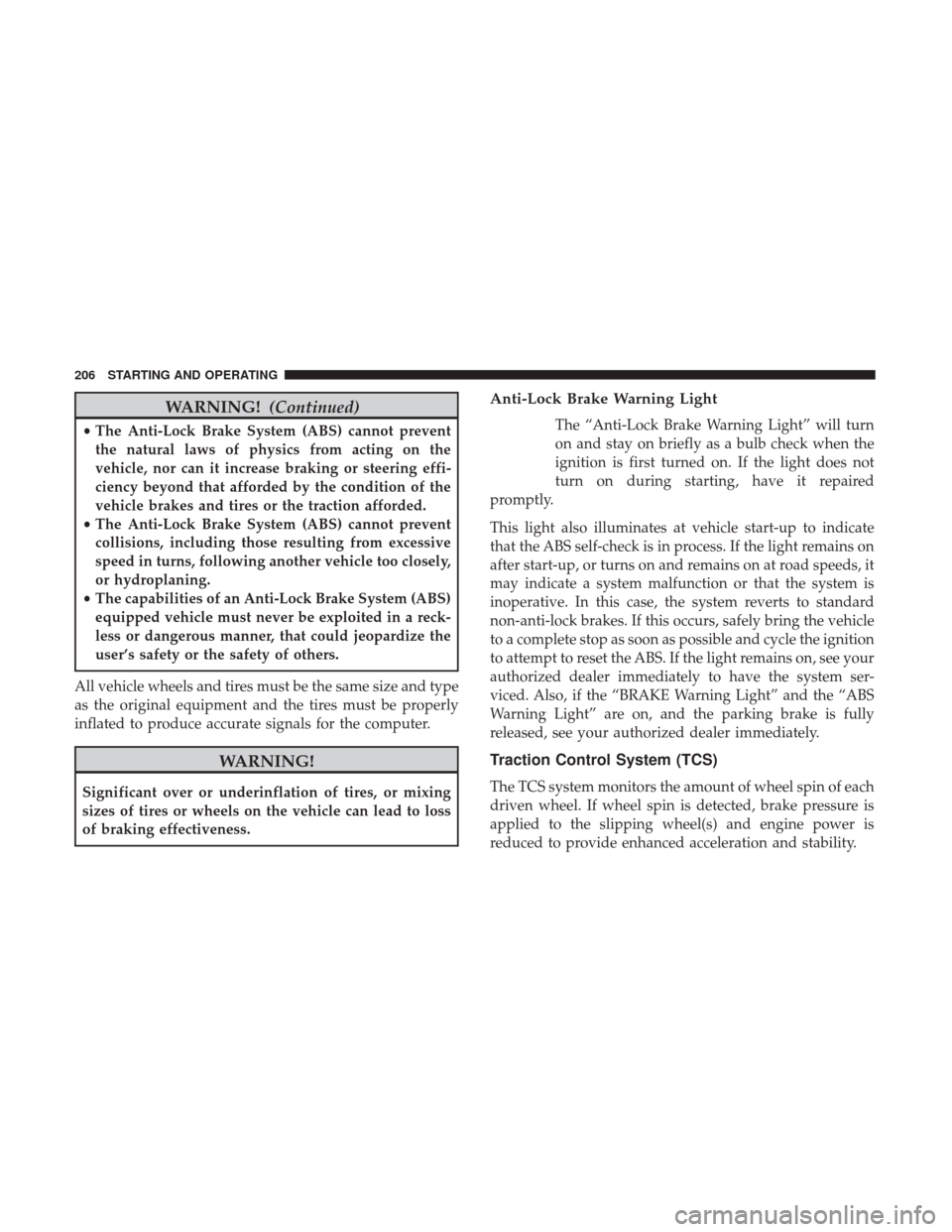
WARNING!(Continued)
•The Anti-Lock Brake System (ABS) cannot prevent
the natural laws of physics from acting on the
vehicle, nor can it increase braking or steering effi-
ciency beyond that afforded by the condition of the
vehicle brakes and tires or the traction afforded.
• The Anti-Lock Brake System (ABS) cannot prevent
collisions, including those resulting from excessive
speed in turns, following another vehicle too closely,
or hydroplaning.
• The capabilities of an Anti-Lock Brake System (ABS)
equipped vehicle must never be exploited in a reck-
less or dangerous manner, that could jeopardize the
user’s safety or the safety of others.
All vehicle wheels and tires must be the same size and type
as the original equipment and the tires must be properly
inflated to produce accurate signals for the computer.
WARNING!
Significant over or underinflation of tires, or mixing
sizes of tires or wheels on the vehicle can lead to loss
of braking effectiveness.
Anti-Lock Brake Warning Light
The “Anti-Lock Brake Warning Light” will turn
on and stay on briefly as a bulb check when the
ignition is first turned on. If the light does not
turn on during starting, have it repaired
promptly.
This light also illuminates at vehicle start-up to indicate
that the ABS self-check is in process. If the light remains on
after start-up, or turns on and remains on at road speeds, it
may indicate a system malfunction or that the system is
inoperative. In this case, the system reverts to standard
non-anti-lock brakes. If this occurs, safely bring the vehicle
to a complete stop as soon as possible and cycle the ignition
to attempt to reset the ABS. If the light remains on, see your
authorized dealer immediately to have the system ser-
viced. Also, if the “BRAKE Warning Light” and the “ABS
Warning Light” are on, and the parking brake is fully
released, see your authorized dealer immediately.
Traction Control System (TCS)
The TCS system monitors the amount of wheel spin of each
driven wheel. If wheel spin is detected, brake pressure is
applied to the slipping wheel(s) and engine power is
reduced to provide enhanced acceleration and stability.
206 STARTING AND OPERATING